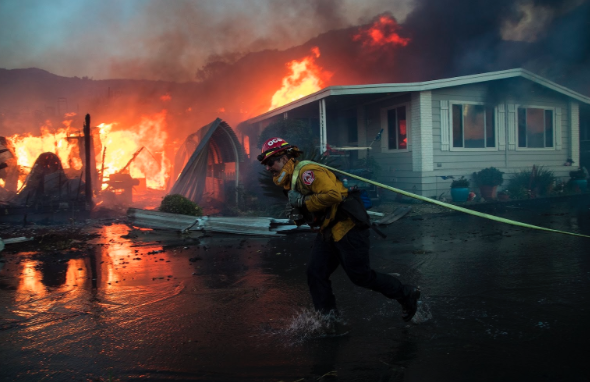CCHS community escapes Lilac fire damage

Photo used with permission from Gina Ferazzi
A fireman from the Oceanside Fire Department bravely rushes to the scene of the Lilac Fire, hose in hand, in an attempt to save the surrounding houses from damage.
Growing up beachside in Southern California definitely comes with a long list of
benefits, but there is one definite disadvantage: fire season.
Fire season, which runs from September to November when dry, windy weather creates a perfect environment for fires to grow at rapid rates, came later than usual this year, and it brought multiple uncontrollable blazes this past week, including the Lilac Fire, which affected many members of the Cathedral Catholic High School community.
“The first I heard of any fires in SoCal was during seventh [period] when one of my students prayed for her family affected by the Thomas Fire in Ventura,” CCHS math teacher Ms. Christine Laporte said. “A few days later, I called my insurance to confirm I had adequate coverage, and that night my area was put under mandatory evacuation.”
Ms. LaPorte was among many members of the CCHS community forced to leave their homes, unsure of whether they will return to unscathed homes or piles of wreckage.
“After making a detailed video of all the items in my home for insurance compensation, I packed a bag full of important documents, photo albums, and special jewelry,” Ms. LaPorte said. “Then, I blessed each room with holy water and asked Mary to protect my house.”
Many other CCHS students also were put in danger as the Lilac Fire burned, including Dean Janikowski ‘19, a student who lives on a large plot of land in Fallbrook with many animals. Fortunately, the Janikowski family, with the help of a family friend, saved all ten of its chickens, two kittens, one dog, and one goat.
Animals in Bonsall, a town known for housing expensive thoroughbred race horses, were put in immense danger during the fires. Some barn owners let their horses run free as they could not get them all safely evacuated. The Del Mar Racetrack offered a helping hand, as it became an animal evacuation center where owners could safely shelter their horses.
“On Thursday, my mom sent me a picture of the fire, which started right by our house, and I assumed we would be evacuated because of how close it was in the picture,” Janikowski said. “I was really worried for my house and animals. It took me four hours to get home, and we evacuated later that night.”
After many days of fighting the blaze, the firefighters finally gained an upper hand Sunday on the inferno, reaching 50 percent containment, which was enough to lift most mandatory evacuation orders.
Thankfully, both Ms. LaPorte and Janikowski returned this week to their homes, which were not damaged by the fires.
Experiencing a mandatory evacuation can seem terrifying, but for California locals, the experience is almost routine.
“I remember in the 2007 fires my family had to evacuate, and I was upset because I couldn’t decide which teddy bear I wanted to bring with me,” CCHS student Halle Way ‘19 said. “I was really scared then, but since then I’ve been under both voluntary and mandatory evacuations multiple times.”
Even though Southern California’s fire season tends to be worse than most, its consistency does not eliminate civilians’ fears of losing their possessions. Supportive friends, family, and most importantly, firemen, are what kept locals sane during the Santa Ana season and recent fires.
Without the California firemen, the thousands of people who were evacuated and thousands of homes that were saved may still be up in flames. Their admirable constant bravery and their ability to contain such horrific fires day in and day mark the sign of heroes.
“The success that was achieved in the control of the Lilac Fire shows the value of strong cooperative agreements and partnerships between cities, the county, and fire and law enforcement agencies,” Oceanside Fire Chief Rick Robinson said. “I can also not say enough about all those citizens who volunteered to help their neighbors and for the public in general who listened to the official warnings and evacuated ahead of the fire’s spread.”
Although more than 150 structures were damaged, the fire went from zero percent contained to 50 percent contained in a matter of three days, which Mr. Robinson believes is all thanks to the favorable change in wind direction, available resources, and dedication from Oceanside’s workers.
“Dozens of city employees worked behind the scenes providing logistical support, staffing the city’s Emergency Operation Center and an evacuation center,” Mr. Robinson said. “It is also important to recognize the men and women who work in our police and fire 911 emergency dispatch centers. Handling hundreds if not thousands of 911 calls and ensuring the right resources are notified and assigned is an essential emergency function.”
The process to the eventual containment of the Lilac Fire was a difficult road, but most importantly, there was no reported loss of life due to the fire, Mr. Robinson said.
Southern California’s paradise does come with the damaging Santa Ana fire season, yet as destructive as it might be, the supportive community that consistently presents itself in time of crisis is impressive.
The San Diego County owes many people thanks that the Lilac fire, although a continuous battle, was able to be stopped when it was, including the 1,659 firefighters assigned to controlled the fire.
According to Valley Center Fire Chief Josef Napier, a total of 140 fire engines, 29 water tenders, 17 fire cat dozers, 33 hand crews, 11 helicopters and 5 air tankers, including a DC-10 air tanker, all of which were committed to the incident for five days with no rest.
“We even had a reinforced response from fire units as far away as Colorado, Arizona, and Montana,” Mr. Napier said
As of Dec. 12, the fire is 92 percent contained.
“Successful outcomes are not by accident,” Mr. Robinson said. “They come from pre-planning and preparing for what might occur, rapid response and application of resources, dedicated personnel, effective leadership, and yes maybe even a little bit of luck.”

As my second year as El Cid Editor-in-Chief begins, I look forward to spending my senior year improving the newspaper and eventually leaving El Cid in...




















































